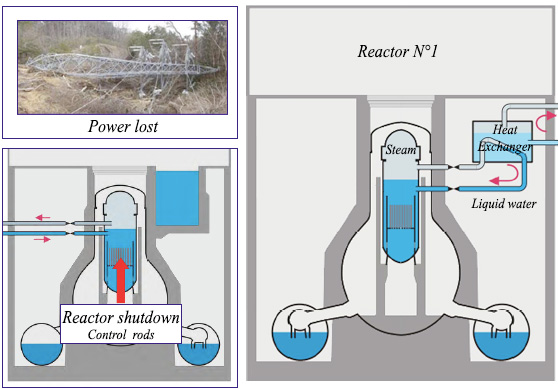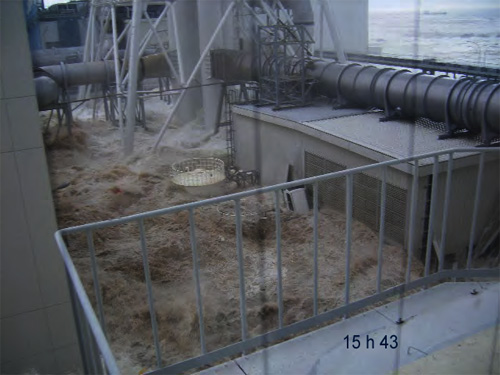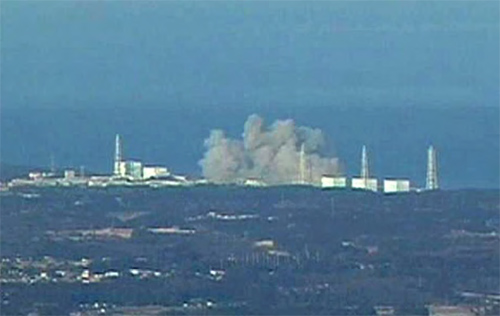Fukushima : Events and Causes
March 11th 2011 : cascade of unlikely accidents …

Reactors shutdowns and losses of power supply
The reactors normally stopped during the earthquake, but the earthquake destroyed the power lines that power the plant. The reactors were then deprived of the power supply network for cooling.
© IN2P3
The earthquake
The magnitude 9 earthquake occurred on March 11, 2011, 300 km off Fukushima, at 2:46 pm and 20 seconds. The reactors were not damaged, but the high voltage lines supplying electricity to reactors 1 to 4 were put out of service.
– 26 secondes after the earthquake, emergency shutdowns of unitts 1, 2 and 3 , unit 4 being already stopped. The shutdowns occured without problems. The fission reactions stopped, but not the heat released by the radioactive decays. The heat released is 6% immediately after shutdown represents, with respect to the release when the reactor in operation. It decreases rapidly during the first moments and then slowly then drops to 0.6% after 1 day and 0.3% after 5 days. Even so, the heat remaining to be evacuated remains considerable: for example for a power of 1000 MWe, it is still 9 MW thermal about a week after shutdown, requiring a supply of several cubic meters of water per hour.
– 1 min 04 : Isolation of the containment building and start up of 11 backup diesels on 12. The emergency cooling of the reactors core was working. That of reactor N°1 was cooled from an insulation condenser. For reactors N°2 and 3, the steam is condensed in the decompressor torus, then reinjected into the vessel. The heat is not removed from the reactor vessel and containment structure.

Floods and decommissioning of emergency diesels
Almost an hour after the earthquake, the tsunami wave drowns the lower part of the plant, putting out of action diesel emergency engines and cold water sources.
© TEPCO
March 11th – 15h41: the Tsunami.
The plant was designed to withstand a 6.5-meter high tsunami. The actual height of the March 11 wave that hit the plant, nearly an hour after the earthquake, exceeded 14 meters. It flooded the emergency diesel engines, putting them out of service, as well as cooling freshwater supplies.
As a result of this loss of power supplies, only batteries still work. The « isolation pumps » which ensured a circulation of water in the tanks stopped one by one: that of reactors N° 1 the 11 at 16:36 and N°3 the 13 at 2:44 (batteries exhausted); that of reactor No. 2: 14 at 13h25 (pump failure).
Residual heat continued to boil the water in the vessel. The thermal power to be evacuated was of the order of ten megawatts, equivalent to the vaporization of 4 to 5 liters of water per second! The vapor pressure rose, requiring the opening of depressurization valves. Steam discharged into the containment structure, causing a drop of the water level in the tank and leading to the exposure of the fuel rods.

Reactor N°1 : first hydrogen explosion
The first hydrogen explosion that disclosed the Fukushima accident occurred on March 12 at 3:36 pm (24 hours after the cooling was stopped). The main radioactive releases from units 2 and 3 occured 2 and 3 days later.
© DR
Lack of cooling and fusion of fuel rods, hydrogen explosions and major radioactive releases
During long hours the hearts of the three reactors were without water supply, in absence of a cold source available. It was decided, bu it was too late, to inject corrosive seawater in desperation because it meant the degradation of the reactors cores. For being too late, TEPCO lost both the reactors it feared to lose and worsened beyond the consequences of the accident.
If the water injection had occurred earlier, only steam would have discharged outside the vessel. Releases would have been innocuous. But in the vessel cores, the water boiled, the temperature rose, the steam passed in the containment structure. The level of the liquid dropped to the point of discovering the top of fuel assemblies. Then the fuel rods melting began and with this the cascade of phenomena which led to a major accident.
When the temperature of the emergent portion of the tubes encasing the fuel reaches 900 ° C, the tubes lose their etancheity, releasing the gaseous or volatile fission products. Then the zirconium of the tubes brutally interacts with the water vapor to decompose it. Considerable quantities of hydrogen are released. Around 1800 ° C, structures melt also. Fuel pellets fall to the bottom of the vessel and below. This is the beginning of a nuclear fuel melting.
Hydrogen and volatile radioactive products went into the containment chambers during discharges of the high pressure steam of the reactor vessels. The pressure in these containment chambers increased dangerously, it became necessary to depressurize them in turn. But the stacks beeing blocked and the valves inaccessible, a mixture of steam, hydrogen and radioelements spreads outside the enclosures in the buildings. Large quantities of hydrogen dispersed there and exploded in contact with oxygen of the air.
A seawater injection was implemented on March 12 at 20h20 for reactor N°1, on March 13 at 9h38 for N°3 and on March 14 at 20h33 for N°2. The resumption of the water supply stopped the dewatering process in the three reactors. The fuel was again under water, but the injection was done in open circuit. Steam produced was continuously discharged into the containment enclosures. The pressure in these enclosures increases dangerously because of this and it was necessary to carry out new depressurizations which release their radioactivity outside. The lower part of the enclosures were filled with radioactive water that would cause later great problems.
The explosion of the N°1 reactor was the first. That of N°3, the most spectacular, destroyed the upper part of the building and messed its service floor with debris. Debris also fell into the pool of the nearby N°4 reactor, that was stopped, but where spent fuel was recently stored. The most serious explosion was the explosion of the N°2 reactor. It occurred in the lower part of the containment building, generating a breach through which highly radioactive water flooded the basements. It was the main source of radioactive contamination of the plant and release in the environment. Fortunately, this major radioacivity release came 4 days after the tsunami. These 4 days gave time to evacuate the population or to put them in shelters.
Understanding the accident of Fukushima Daiichi. IRSN video
This complex sequence of circumstances led to a series of accidents. Some were unexpected. In addition to the natural cataclysm, the concomitance of breakdowns, there were defects in terms of the safety design. A higher dike, more robust backup systems would have been enough to avoid the absence of cooling, the dewatering of the fuel and the release of radioactivity.
Source chronology : Analysis of the Severe Accident Progression in Units 1,2 and 3 at Fukushima Daiichi, Mathias Braun, Peter Volkhoz, Revue Générale Nucléaire N°1 Janvier-Février 2012
Other articles on the subject « Fukushima accident »
Fukushima : Contaminations
Atmospheric releases and map of ground déposits The contaminations due to Fukushima radioactive r[...]
Fukushima decontamination
2014 -2017: Status of clean-up operations The major clean-up program of contaminated areas in Jap[...]
Fukushima Health Impact
Contamination and health controls in Japan The health impacts of the accident primarily concerned[...]
Fukushima today
A long way from reactors cold shutdown to their dismantling .. Today, 8 years after the accident,[...]